|
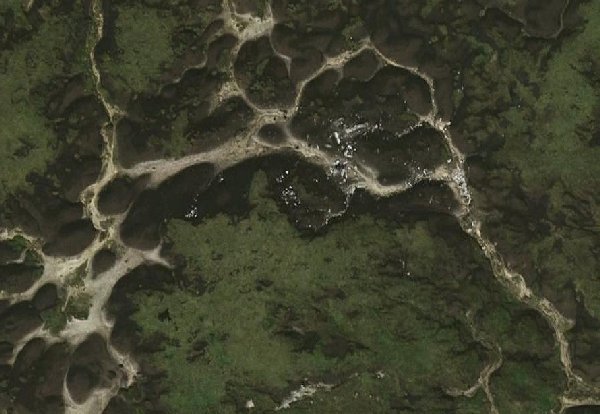  Close
to the A57 Snake Pass just a few miles outside Glossop, a foreboding moor land
ridge called Bleaklow broods over the town. The hills hereabouts are steep sided
and riven through with deep, U shaped valleys. In this area right on the border
between Greater Manchester and the Derbyshire Peak District, the Pennine ridge
is the first serious range of hills that fat, water laden clouds rolling in from
the Irish Sea will encounter after the flat coastal plain. The prevailing
weather not surprisingly is extremely wet - and not a little windy - and the
ground is composed of deep layers of rich peat laid down by the innumerable bogs
over thousands of years. These barren hills are just a small part of the
Pennines, the backbone of England, which runs from the heart of the Midlands all
the way up to the Scottish border. Just a few miles further along the Snake Pass
the terrain around the three great reservoirs of Howden, Derwent and Ladybower,
was used by the RAF's 617 "Dambuster" squadron to great effect for low level
practise attacks. Close
to the A57 Snake Pass just a few miles outside Glossop, a foreboding moor land
ridge called Bleaklow broods over the town. The hills hereabouts are steep sided
and riven through with deep, U shaped valleys. In this area right on the border
between Greater Manchester and the Derbyshire Peak District, the Pennine ridge
is the first serious range of hills that fat, water laden clouds rolling in from
the Irish Sea will encounter after the flat coastal plain. The prevailing
weather not surprisingly is extremely wet - and not a little windy - and the
ground is composed of deep layers of rich peat laid down by the innumerable bogs
over thousands of years. These barren hills are just a small part of the
Pennines, the backbone of England, which runs from the heart of the Midlands all
the way up to the Scottish border. Just a few miles further along the Snake Pass
the terrain around the three great reservoirs of Howden, Derwent and Ladybower,
was used by the RAF's 617 "Dambuster" squadron to great effect for low level
practise attacks.
At the top of Bleaklow,
scattered far and wide throughout a large gulley system, can be found the
remains of an American World War Two era Boeing Superfortress bomber. It is a
relatively short walk up to the crash site from the road and a large part of the
route is actually a good stone path - only the final ascent to the highest part
of the ridge is across the boggy peat which is so much a feature in this area.
It is well worth the effort
of getting up there to see what remains today. The plane came down in 1948, but
sixty three years on many major structural spars remain, undercarriage struts,
pulley wheels for internal control cables, and even large sections of the light
aluminium alloy from which the fuselage was constructed, have survived the
ravishes of the Bleaklow weather. The most instantly recognisable parts of the
aeroplane are the four 18 cylinder Wright R-3350-23 engines, still in a
remarkable state of preservation.
This particular power plant was problematic to say the least and caused problems
for several B29's due to it's propensity for bursting into flames, however
engine malfunction is not thought to have been the cause of this particular
Superfortress' demise - the sad reality appears to be that she was flown into
the ground by instrument malfunction and/or pilot error, and it is very
obvious from the state of the wreckage that the crew wouldn't have stood a cat
in hell's chance of surviving the impact. At least it must have been quick for
they can have had very little idea about what was coming.

Wikipedia has this to say about the Boeing B29 Superfortress...
"The
B-29 Superfortress is a four-engine
propeller-driven
heavy bomber
designed by
Boeing that was
flown primarily by the United States Air Forces in late
World War II and
through the
Korean War. The
B-29 was one of the largest
aircraft to see
service during World War II. A very advanced bomber for this time
period, it included features such as a pressurized cabin,
an electronic
fire-control system, and remote-controlled machine-gun turrets. The name
"Superfortress" was derived from that of its well-known predecessor, the
B-17 Flying Fortress.
Though the B-29 was designed as a high-altitude daytime bomb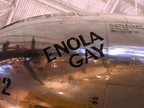 er, in
practice it actually flew more low-altitude
night time
incendiary bombing
missions. It was the primary aircraft in the
American firebombing
campaign against the
Empire of Japan
in the final months of World War II, and carried out the
atomic bombings
that
destroyed Hiroshima
and Nagasaki. er, in
practice it actually flew more low-altitude
night time
incendiary bombing
missions. It was the primary aircraft in the
American firebombing
campaign against the
Empire of Japan
in the final months of World War II, and carried out the
atomic bombings
that
destroyed Hiroshima
and Nagasaki.
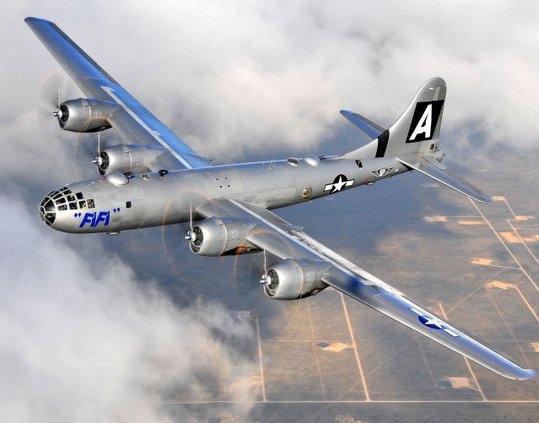 Unlike
many other World War II-era bombers, the B-29 remained in service long
after the war ended, with a few even being employed as flying television
transmitters for the
Stratovision
company. The B-29 served in various roles throughout the 1950s. The
British
Royal Air Force
flew the B-29 and used the name Washington for the type, and the Soviet
Union produced an unlicensed copy as the
Tupolev Tu-4. The
B-29 was the progenitor of a series of Boeing-built bombers, transports,
tankers, reconnaissance aircraft and trainers including the
B-50 Superfortress
(the
first aircraft to fly around the world
non-stop) which was essentially a re-engined B-29. The type was finally
retired in the early 1960s, with 3,970 aircraft in all built. While
dozens of B-29s have survived through today as static displays,
only one remains
on active flying status. Unlike
many other World War II-era bombers, the B-29 remained in service long
after the war ended, with a few even being employed as flying television
transmitters for the
Stratovision
company. The B-29 served in various roles throughout the 1950s. The
British
Royal Air Force
flew the B-29 and used the name Washington for the type, and the Soviet
Union produced an unlicensed copy as the
Tupolev Tu-4. The
B-29 was the progenitor of a series of Boeing-built bombers, transports,
tankers, reconnaissance aircraft and trainers including the
B-50 Superfortress
(the
first aircraft to fly around the world
non-stop) which was essentially a re-engined B-29. The type was finally
retired in the early 1960s, with 3,970 aircraft in all built. While
dozens of B-29s have survived through today as static displays,
only one remains
on active flying status.
A
transport derived from the B-29 was the
C-97, first flown
in 1944, followed by its commercial airliner variant, the Boeing
Model 377 Stratocruiser
in 1947. This bomber-to-airliner derivation was similar to the
B-17/Model
307 evolution. The tanker variant of
the B-29 was introduced in 1948 as the
KB-29, followed
by the Model 377-derivative
KC-97 introduced
in 1950. Later jet-powered models from Boeing carried on the lineage,
including the
B-47 Stratojet
and
B-52 Stratofortress
bombers, as well as the "Dash
80", from which today's modern
airliners are evolved. A heavily modified line of outsized-cargo
variants of the B-29-derived Stratocruiser is the
Guppy/Mini
Guppy/Super
Guppy which remain in service today
with operators such as
NASA."
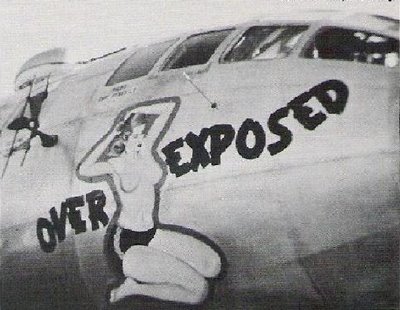 The
Bleaklow Superfortress was not a standard B29 heavy bomber; rather she was
actually an RB-29, the photographic reconnaissance variant of the
aircraft. Soon after the end of the war it became imperative for the
western powers to monitor the build up and deployment of Soviet troops and
in June 1948 the Russians began a blockade of Berlin prompting the now
famous Berlin Airlift which continued until the 12th. May 1949. The crisis
sealed the issue and photo missions were flown from the UK right up
until the end of the Cold War. The
Bleaklow Superfortress was not a standard B29 heavy bomber; rather she was
actually an RB-29, the photographic reconnaissance variant of the
aircraft. Soon after the end of the war it became imperative for the
western powers to monitor the build up and deployment of Soviet troops and
in June 1948 the Russians began a blockade of Berlin prompting the now
famous Berlin Airlift which continued until the 12th. May 1949. The crisis
sealed the issue and photo missions were flown from the UK right up
until the end of the Cold War.
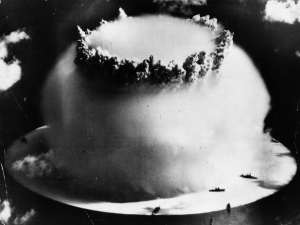 American
flyers, and indeed those of many other nations too, have always had a
strong tradition of naming their aircraft and decorating the nose or
cockpit sides with appropriate artwork, some of which was extremely racy
given the moral values of the time. This particular RB29 was no exception.
part of the USAF's 16th Photographic Reconnaissance Squadron, she was
named "Overexposed". The squadron was based at RAF Scampton in
Lincolnshire at the time of the crash but Overexposed had already flown
many, many miles in her relatively short life. She was also one of three
RB29s which had accompanied the B29 tasked with deploying the "Able"
atomic bomb in 1946 at Bikini Atoll in the Pacific. American
flyers, and indeed those of many other nations too, have always had a
strong tradition of naming their aircraft and decorating the nose or
cockpit sides with appropriate artwork, some of which was extremely racy
given the moral values of the time. This particular RB29 was no exception.
part of the USAF's 16th Photographic Reconnaissance Squadron, she was
named "Overexposed". The squadron was based at RAF Scampton in
Lincolnshire at the time of the crash but Overexposed had already flown
many, many miles in her relatively short life. She was also one of three
RB29s which had accompanied the B29 tasked with deploying the "Able"
atomic bomb in 1946 at Bikini Atoll in the Pacific.
In 2006 we
dived on many of the ship wrecks at Bikini Atoll including the
aircraft carrier USS Saratoga, which were all sunk during the
Operation Crossroads atomic bomb tests. You can view the photographs
we took on the wrecks on our Bikini Atoll diving page by clicking the
"Baker" A bomb photo link here to the right...
Close to Warrington
in Lancashire - Warrington mysteriously "moved" to Cheshire only in the
latter part of the 20th. century - was situated the huge American
logistics airbase named Burtonwood. The M62 motorway runs slap bang
through the middle of the base now and little evidence remains of the site
other than a couple of hangers converted for use as industrial units. By
comparison RAF Scampton's American presence was quite small so all mail
and pay destined for aircrew based there was routed through Burtonwood and
had to be collected on regular re-supply flights. On 3rd November 1948
Overexposed was tasked with just such a mission and although only a
minimal flight crew would be required the rest of the operational crew
chose to go along for the ride bringing the total personnel aboard the
plane to 13. This was not at all unusual - Scampton was rather short
on creature comforts for the Americans, especially in view of the
austerity measures in the post war UK where rationing was still in
operation for the civilian population. But the vast logistics base at
Burtonwood had just about everything a Yank away from home could desire -
it was in effect a small part of America displaced onto English soil, even
UK currency had to be converted into dollars for any none Americans
visiting the base! No surprise then that the entire crew jumped at the
chance of some quality leisure time just a 25 minute flight away.
The November weather
that day was not good and the cloud base was considerably lower than 2000
feet. If you stand now at the crash site and face roughly due west you are
looking straight out towards the Burtonwood final approach.
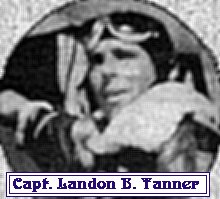 At
11.15 AM Overexposed came across the moors flying to all intents and
purposes at ground level. The crew must have been eagerly anticipating a
hearty meal in the mess in a little over 30 minutes time but Overexposed
crashed into the ground at Higher Shelf Stones a few hundred yards from
the highest point of Bleaklow (2077 feet). It is not clear why Captain
Landon Tanner flew into the ground that day and we will never know for
certain. The fact is that Tanner had no need fly below 2000 feet at that
point as he was still about another seven minutes flying time short of his
descent point into the runway at Burtonwood, and his maps would show
clearly the high ground he was crossing. He knew full well how low the
cloud base was, both from his pre-flight meteorological reports at
Scampton, and in bound from Burtonwood via Overexposed's radio, so any
attempt to get below the clouds in order to gain visual contact with the
ground whilst still flying over known high ground should be discounted.
The most likely explanation was navigational error though I have often
wondered if perhaps they had an altimeter fault. What is without doubt is
that the wind that day was very strong and right on the nose of the
aircraft. The effect of the headwind would be to throw off the navigator's
positional calculations significantly - in short Tanner probably began his
descent too soon believing that they were some 30 miles clear of Bleaklow
and already over the low ground just short of the final approach into
Burtonwood. Given the state of the weather that day and the known head
wind perhaps Tanner should have flown at an altitude dictated by the safe
operational height information for the Burtonwood sector and let down in a
spiral pattern once he picked up the Burtonwood beacon. At
11.15 AM Overexposed came across the moors flying to all intents and
purposes at ground level. The crew must have been eagerly anticipating a
hearty meal in the mess in a little over 30 minutes time but Overexposed
crashed into the ground at Higher Shelf Stones a few hundred yards from
the highest point of Bleaklow (2077 feet). It is not clear why Captain
Landon Tanner flew into the ground that day and we will never know for
certain. The fact is that Tanner had no need fly below 2000 feet at that
point as he was still about another seven minutes flying time short of his
descent point into the runway at Burtonwood, and his maps would show
clearly the high ground he was crossing. He knew full well how low the
cloud base was, both from his pre-flight meteorological reports at
Scampton, and in bound from Burtonwood via Overexposed's radio, so any
attempt to get below the clouds in order to gain visual contact with the
ground whilst still flying over known high ground should be discounted.
The most likely explanation was navigational error though I have often
wondered if perhaps they had an altimeter fault. What is without doubt is
that the wind that day was very strong and right on the nose of the
aircraft. The effect of the headwind would be to throw off the navigator's
positional calculations significantly - in short Tanner probably began his
descent too soon believing that they were some 30 miles clear of Bleaklow
and already over the low ground just short of the final approach into
Burtonwood. Given the state of the weather that day and the known head
wind perhaps Tanner should have flown at an altitude dictated by the safe
operational height information for the Burtonwood sector and let down in a
spiral pattern once he picked up the Burtonwood beacon.
He didn't, why we
will never know...
|
Below you
can view the best of the photographs which we took at this site.
If you wish to view any of
these pictures in a much larger size then just click on the thumbnail of
your choice and it will open a full size picture in a secondary
window... |
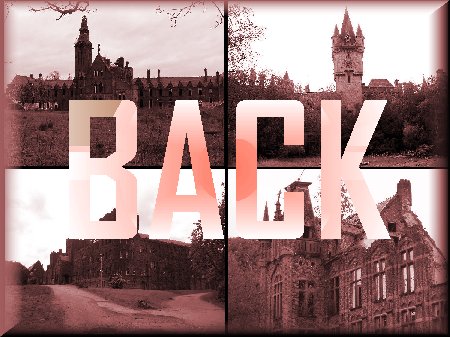 |
|



 Unlike
many other World War II-era bombers, the B-29 remained in service long
after the war ended, with a few even being employed as flying television
transmitters for the
Unlike
many other World War II-era bombers, the B-29 remained in service long
after the war ended, with a few even being employed as flying television
transmitters for the
 The
Bleaklow Superfortress was not a standard B29 heavy bomber; rather she was
actually an RB-29, the photographic reconnaissance variant of the
aircraft. Soon after the end of the war it became imperative for the
western powers to monitor the build up and deployment of Soviet troops and
in June 1948 the Russians began a blockade of Berlin prompting the now
famous Berlin Airlift which continued until the 12th. May 1949. The crisis
sealed the issue and photo missions were flown from the UK right up
until the end of the Cold War.
The
Bleaklow Superfortress was not a standard B29 heavy bomber; rather she was
actually an RB-29, the photographic reconnaissance variant of the
aircraft. Soon after the end of the war it became imperative for the
western powers to monitor the build up and deployment of Soviet troops and
in June 1948 the Russians began a blockade of Berlin prompting the now
famous Berlin Airlift which continued until the 12th. May 1949. The crisis
sealed the issue and photo missions were flown from the UK right up
until the end of the Cold War. 
 At
11.15 AM Overexposed came across the moors flying to all intents and
purposes at ground level. The crew must have been eagerly anticipating a
hearty meal in the mess in a little over 30 minutes time but Overexposed
crashed into the ground at Higher Shelf Stones a few hundred yards from
the highest point of Bleaklow (2077 feet). It is not clear why Captain
Landon Tanner flew into the ground that day and we will never know for
certain. The fact is that Tanner had no need fly below 2000 feet at that
point as he was still about another seven minutes flying time short of his
descent point into the runway at Burtonwood, and his maps would show
clearly the high ground he was crossing. He knew full well how low the
cloud base was, both from his pre-flight meteorological reports at
Scampton, and in bound from Burtonwood via Overexposed's radio, so any
attempt to get below the clouds in order to gain visual contact with the
ground whilst still flying over known high ground should be discounted.
The most likely explanation was navigational error though I have often
wondered if perhaps they had an altimeter fault. What is without doubt is
that the wind that day was very strong and right on the nose of the
aircraft. The effect of the headwind would be to throw off the navigator's
positional calculations significantly - in short Tanner probably began his
descent too soon believing that they were some 30 miles clear of Bleaklow
and already over the low ground just short of the final approach into
Burtonwood. Given the state of the weather that day and the known head
wind perhaps Tanner should have flown at an altitude dictated by the safe
operational height information for the Burtonwood sector and let down in a
spiral pattern once he picked up the Burtonwood beacon.
At
11.15 AM Overexposed came across the moors flying to all intents and
purposes at ground level. The crew must have been eagerly anticipating a
hearty meal in the mess in a little over 30 minutes time but Overexposed
crashed into the ground at Higher Shelf Stones a few hundred yards from
the highest point of Bleaklow (2077 feet). It is not clear why Captain
Landon Tanner flew into the ground that day and we will never know for
certain. The fact is that Tanner had no need fly below 2000 feet at that
point as he was still about another seven minutes flying time short of his
descent point into the runway at Burtonwood, and his maps would show
clearly the high ground he was crossing. He knew full well how low the
cloud base was, both from his pre-flight meteorological reports at
Scampton, and in bound from Burtonwood via Overexposed's radio, so any
attempt to get below the clouds in order to gain visual contact with the
ground whilst still flying over known high ground should be discounted.
The most likely explanation was navigational error though I have often
wondered if perhaps they had an altimeter fault. What is without doubt is
that the wind that day was very strong and right on the nose of the
aircraft. The effect of the headwind would be to throw off the navigator's
positional calculations significantly - in short Tanner probably began his
descent too soon believing that they were some 30 miles clear of Bleaklow
and already over the low ground just short of the final approach into
Burtonwood. Given the state of the weather that day and the known head
wind perhaps Tanner should have flown at an altitude dictated by the safe
operational height information for the Burtonwood sector and let down in a
spiral pattern once he picked up the Burtonwood beacon.



















